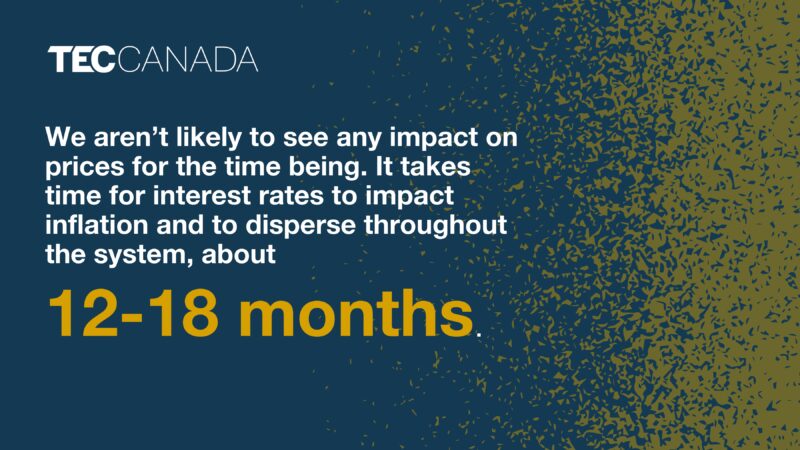Lower Interest Rates in Canada: Enough for Businesses?
Despite all the doom and gloom in the news (Canada’s unemployment rate, Canada’s GDP growth, Canada’s GDP per capita, and a possible Canadian recession), there remains one beacon of hope…interest rates!
The Bank of Canada’s interest rate has recently come down again, but is it enough? In the following article, we’ll discuss what this means for business leaders and our economy.
Back to Basics
Many factors during and after the pandemic led to inflation: supply chain disruptions, labour shortages, government stimulus, carbon tax, ballooning asset values, and ultimately a shift in supply and demand.
A weak Canadian dollar also makes imported products and materials more expensive, fueling inflation and a trade deficit.
This is where interest rates come in. The remedy to inflation is intentionally increasing the cost of borrowing money (interest rates), making prices go up to slow demand for goods and services. This allows supply to catch up with demand which then brings prices back down.
By holding the prime rate in Canada right around the 5% mark, with a recent decrease to 4.75% in June and 4.5% in July, inflation seems to be coming down.
Inflation rates peaked in June 2022 at 8.1% (compared to June 2021) and have since come down to around 2.7% year over year. However, there was a recent increase in May to 2.9%, leaving people’s hopes of a consistent downward trend deflated (pun intended). The ideal inflation rate is approximately 2%, to keep up with money printing, make prices predictable, and the market effectively competitive.
Act Now, Results Later

Inflation cooling doesn’t mean prices are coming down, it just means prices aren’t going up as fast.
We aren’t likely to see any impact on prices for the time being. It takes time for interest rates to impact inflation and to disperse throughout the system, about 12-18 months. In theory, this means we are currently seeing the effects of interest rates from about a year ago.
Interest payments on larger debts such as car loans, business investments, and mortgages may come down sooner as they are more directly affected by this move in interest rates. This could encourage purchases, but most people are likely still waiting.
We Aren’t Out of the Woods Yet
While the recent decrease in inflation is positive, there remains the chance that it could rebound. Suppose the decrease in the interest payments on debts provides enough relief for demand to resurge before supply can catch up. In that case, inflation will begin to increase again.
If this predicament seems like a Catch-22, that’s because it is. On one hand, lower rates can help to support economic growth, which might ease some of the pressures that have been driving inflation higher. On the other hand, if the economy overheats due to too much cheap credit, it could lead to higher inflation again. The Bank of Canada has stated that it will be cautious with more rate cuts in the future to avoid premature easing that could spike inflation, particularly in sensitive areas like housing.
As outlined in the latest TEC Canada Andersen Monthly Economic Report, the 3-month core inflation rate ending in May was up to 3.2%. When compared with the 2.2% 3-month inflation rate ending in April, it is doubtful that lower rates have taken hold.
Navigating Interest Rates in Canada
“The overall weakness in the economy is pulling inflation down. At the same time, price pressure in shelter and other services is holding inflation up.” – Tiff Macklem, Governor of the Bank of Canada
As a business leader or concerned citizen, “weakness in the economy” is not usually what you’d like to hear. You’re likely feeling the pinch of an increased cost of living and doing business, from housing and leases to grocery prices and materials. Consequently, consumer spending is decreasing. Unfortunately, this will likely continue for the time being.
However, the recent decrease in interest rates has ignited some confidence in the economy. Consumers and business leaders will likely be waiting to see more cuts before resuming spending and taking on more debt. Mortgage rates will decrease giving some extra cash to households to spend on other goods and services.
When managing the cost of doing business, business leaders should be transparent with their customers. If people feel that they are being taken advantage of through unreasonable price increases or decreases in product quality, it can hurt a company’s reputation long term. There are various pricing strategies available that reflect the value of products and take advantage of unrealized price ceilings.
While declining interest rates can stimulate economic activity and support growth, there is a delicate balance to be maintained to avoid triggering another round of inflation. The Bank of Canada’s interest rate approach to managing rate cuts reflects this balance, aiming to ensure long-term price stability while supporting economic growth.
To do our part, many are focused on saving during this current crunch on expenses. This is ideal as it will hopefully lead to a balanced supply and demand. Businesses can hunker down and deploy their capital wisely and creatively. This might mean exploring new areas for revenue or taking consistent steps in preparation for ideal conditions.
One particularly wise investment would be to invest in yourself as a leader. You can do so by joining a peer group of like-minded business leaders who support one another and solve each other’s problems as a team. See the impact peer groups have had on entrepreneurs such as Andrea Gomez and CEOs such as Dianne Cupples.




